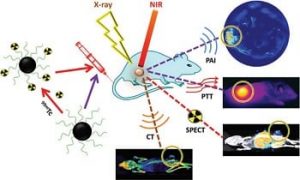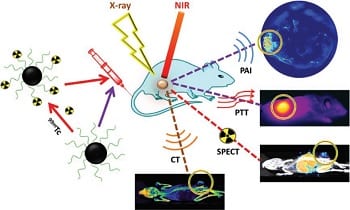Molecular imaging technologies such as ultrasound imaging, magnetic resonance imaging, and computed tomography have become indispensable tools in precision diagnosis and treatment of diseases. Each imaging technology has its own advantages and disadvantages, however, a combination of complementary imaging technologies is an important strategy to overcome the shortcomings of individual imaging technology. In addition, integration of multiple therapeutic functions into multimodal imaging probes has been the cutting edge of molecular imaging. Therefore, from the perspective of fundamental and practical research, developing highly sensitive multifunctional theranostic probes is crucial for precision medicine.
 The research team from the Center for Molecular Imaging and Nuclear Medicine of Soochow University has successfully prepared ultrasmall anionic-deficient WO3-x nanotheranostic probes. These ultrasmall probes can be efficiently accumulated in a tumor through the enhanced permeability and retention effect, and used for diagnosis and treatment of cancer. Very recently, the same team prepared cationic-deficient probes at ambient conditions, i.e. PEGylated copper-deficient ultrasmall Cu2-xSe nanocrystals which exhibit excellent water solubility and biocompatibility. These ultrasmall Cu2-xSe nanoprobes exhibit great potential in photoacoustic imaging and photothermal therapy due to their strong localized surface plasmon resonances (LSPR) in the near-infrared (NIR) window and high photothermal conversion efficiency. They also show potential in CT imaging due to the large attenuation coefficient of Cu and Se to the X-rays, and the CT image of tumor was obtained successfully with assistance of Cu2-xSe nanocrystals. In addition, they can be employed to construct SPECT/CT probes for quantifying the distribution of probes by counting the γ-rays from the radioisotopes (e.g. 99mTc). The combined use of photoacoustic imaging, CT imaging, SPECT/CT, and photothermal therapy has led to promising results in detection and treatment of cancer. This research provides new insights for the clinical diagnosis and treatment of cancer.
The research team from the Center for Molecular Imaging and Nuclear Medicine of Soochow University has successfully prepared ultrasmall anionic-deficient WO3-x nanotheranostic probes. These ultrasmall probes can be efficiently accumulated in a tumor through the enhanced permeability and retention effect, and used for diagnosis and treatment of cancer. Very recently, the same team prepared cationic-deficient probes at ambient conditions, i.e. PEGylated copper-deficient ultrasmall Cu2-xSe nanocrystals which exhibit excellent water solubility and biocompatibility. These ultrasmall Cu2-xSe nanoprobes exhibit great potential in photoacoustic imaging and photothermal therapy due to their strong localized surface plasmon resonances (LSPR) in the near-infrared (NIR) window and high photothermal conversion efficiency. They also show potential in CT imaging due to the large attenuation coefficient of Cu and Se to the X-rays, and the CT image of tumor was obtained successfully with assistance of Cu2-xSe nanocrystals. In addition, they can be employed to construct SPECT/CT probes for quantifying the distribution of probes by counting the γ-rays from the radioisotopes (e.g. 99mTc). The combined use of photoacoustic imaging, CT imaging, SPECT/CT, and photothermal therapy has led to promising results in detection and treatment of cancer. This research provides new insights for the clinical diagnosis and treatment of cancer.

















